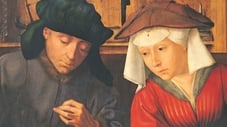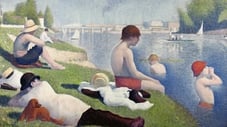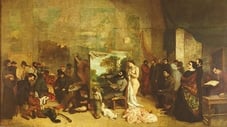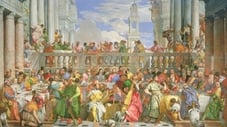Season 1 (Final Season Split)
5 Episodes
16th century Antwerp was like 1950s New York. The city of craftsmen and fishermen at the entrance to the North Sea became a leading finance hub, facilitated by European exploration and new trade routes. This work by Quentin Metsys is a subtle criticism of that world and its era, warning about the flow of money when it is detached from all forms of religious and moral considerations. This film examines the influences of Jan Van Eyck and Leonardo Da Vinci on the work; analyzes composition, painting technique, and object symbolism; and outlines events that would lead to the Dutch Revolt.
Read MoreIn the mid-17th century, Madrid experienced its Golden Age. The Royal Alcazar of Madrid, a legacy of the Muslim sovereignty that had dominated the region for a long time, became the residence of the royal family and the centre of the Spanish court. Diego Velasquez' canvas plunges us into the practices and traditions of the Hapsburgs of Spain. But more importantly, the work is a recursive reflection of reality: between model, viewer and artist, we no longer know who is looking at who.
Read MoreAt the end of the 19th century, Asnieres resembled a seaside resort. The cheering crowd that came to attend the regattas animated the banks of the Seine, and the rowing club was always full. When he painted his canvas, Georges Seurat understood that his current era was totally turned towards a fascinating and ruthless religion: progress. Determined that art should not remain left out of these drastic changes underway, he invented pointillism.
Read MoreParis shone brightly in the second half of the 19th century, with its fashionable restaurants, and its cabarets and theatres, which provided the spectacle of a carefree society. The industrial revolution produced wealth, and fortunes were amassed and lost.
Gustave Courbet's work is politically involved and provocative. It reveals his support for revolutionary movements, and condemns Napoleon III's authoritarian regime. In addition to its critical dimension, the canvas has an air of mystery, and depicts contradictions.
Read MoreIn "The Wedding at Cana", Paolo Veronese transposes the biblical tale of Christ's first miracle to the scene of a sumptuous Venetian banquet. This documentary explores the historical context of 16th century Venice, a wealthy and politically stable city in which artists such as Veronese, Titian, and Jacobo Tintoretto were granted freedom from religious censorship. It looks at Palladio's architectural influences, presents a theory that "The Wedding at Cana" may represent the crowning ceremony of a Doge's wife, and examines how Veronese combines the sacred and profane in his works. Finally, it looks at the painter's use of perspective, colors, and composition.
Read More




